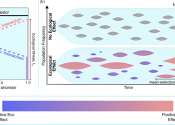Unlocking the mystery of preexisting drug resistance: Study sheds light on cancer evolution
The evolution of resistance to diseases, from infectious illnesses to cancers, poses a formidable challenge.
Jul 15, 2024
0
19
The evolution of resistance to diseases, from infectious illnesses to cancers, poses a formidable challenge.
Jul 15, 2024
0
19

"Personalized" hip replacement surgery might be just what the doctor ordered for people with hip arthritis—according to new research. Using advanced technology from other industries such as automotive and manufacturing, ...
Jul 11, 2024
0
0

Researchers at North Carolina State University have demonstrated a new method that leverages artificial intelligence (AI) and computer simulations to train robotic exoskeletons to autonomously help users save energy while ...
Jun 12, 2024
0
4

A team of Vanderbilt researchers has created a new series of drug candidates against a hard-to-target receptor involved in the formation of blood clots. The research, spearheaded by the labs of Jens Meiler, research professor ...
Jun 11, 2024
0
68

In pausing to think before making an important decision, we may imagine the potential outcomes of different choices we could make. While this "mental simulation" is central to how we plan and make decisions in everyday life, ...
Jun 7, 2024
0
72

The shape of the heart cavities and the angle at which the pulmonary veins reach them are not always the same; rather, they vary according to the anatomical characteristics of each subject. Recently, research by UPF and the ...
May 28, 2024
0
19

Doctoral candidate David Versluis successfully simulated an infant gut. This is crucial for research on improvements in formula milk. Currently, such research primarily relies on diaper contents, which is not optimal. Versluis ...
Apr 25, 2024
0
0

Researchers have shown for the first time that a crucial interface in a protein that drives cancer growth could act as a target for more effective treatments.
Mar 19, 2024
0
47

Amyotrophic lateral sclerosis (ALS) and frontotemporal dementia (FTD) are neurodegenerative diseases that commonly occur in middle-aged people. FTD is second only to Alzheimer's disease in terms of dementia prevalence. Both ...
Mar 18, 2024
0
17

Joint research led by Yu Toyoshima and Yuichi Iino of the University of Tokyo has demonstrated individual differences in, and successfully extracted commonalities from, the whole-brain activity of roundworms. The researchers ...
Mar 15, 2024
0
62

A computer simulation, a computer model or a computational model is a computer program, or network of computers, that attempts to simulate an abstract model of a particular system. Computer simulations have become a useful part of mathematical modeling of many natural systems in physics (computational physics), chemistry and biology, human systems in economics, psychology, and social science and in the process of engineering new technology, to gain insight into the operation of those systems, or to observe their behavior.
Computer simulations vary from computer programs that run a few minutes, to network-based groups of computers running for hours, to ongoing simulations that run for days. The scale of events being simulated by computer simulations has far exceeded anything possible (or perhaps even imaginable) using the traditional paper-and-pencil mathematical modeling: over 10 years ago, a desert-battle simulation, of one force invading another, involved the modeling of 66,239 tanks, trucks and other vehicles on simulated terrain around Kuwait, using multiple supercomputers in the DoD High Performance Computer Modernization Program; a 1-billion-atom model of material deformation (2002); a 2.64-million-atom model of the complex maker of protein in all organisms, a ribosome, in 2005; and the Blue Brain project at EPFL (Switzerland), began in May 2005, to create the first computer simulation of the entire human brain, right down to the molecular level.
This text uses material from Wikipedia, licensed under CC BY-SA